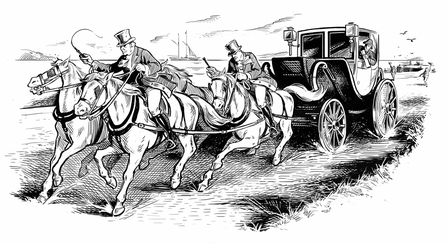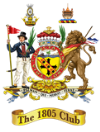Preparations for the 2005 Bicentenary events
It would have been impossible in 2005 to replicate precisely the events of 1805. By 2005 the 1805 road system had been substantially altered and the horse drawn coach system had been replaced by automobiles and railroads. The 2005 recreation had necessarily to be to a substantial extent symbolic, while aiming to conform as closely as possible to the events of 1805.
A. Replication of The Ocean Phase
The first requirement was to seek a suitable ship to replicate the Sea Phase of the project, the voyage of about 1000 miles from Cape Trafalgar by the HM Schooner Pickle to Falmouth. For this, we obtained the generous support of the Jubilee Sailing Trust who operate two training ships for young disabled people. They agreed to operate a voyage following the track of the Pickle in one of these ships, appropriately named Lord Nelson. She was to carry a New Trafalgar Dispatch, of which details are given below, a facsimile of Admiral Collingwood’s first Dispatch, and in addition, a Spanish translation of the New Trafalgar Dispatch.
B. Replication of The Land Phase
Confirmation of the route
Fortuitously, Captain Peter Hore had discovered the expense account of Lieutenant Lapenotiere in the Admiralty archives at Kew. Starting at Falmouth, this lists his 21 stops for post chaise and horse changes along the 271 mile route from Falmouth before his arrival at the Admiralty at No 12 Whitehall in London. The discovery of the expense account was especially fortunate. Lapenotiere’s actual route as listed in the account differed significantly from that he had been assumed to have taken at the time of the Centenary of Trafalgar in 1905. We now had clear documentary confirmation of the correct route.
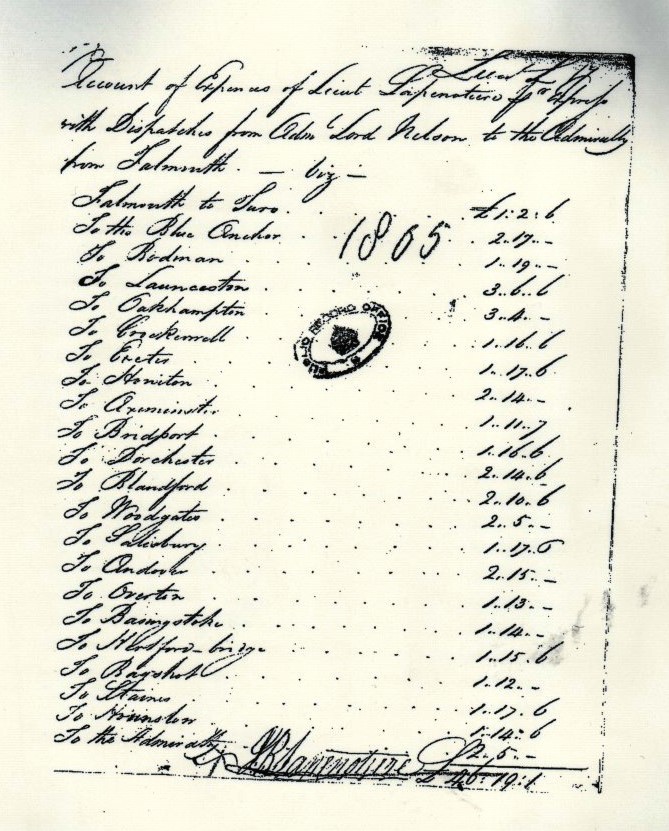
A scan of the original Lapenotiere receipt from 1805, showing the 21 post-chaise changes
The Trafalgar Way map
Having now confirmed the correct route, it was important to establish it as a permanent entity. First, therefore, we named it as The Trafalgar Way, somewhat ironically as an analogy to the Route Napoleon. This route runs northward from Nice in France and is that taken by Napoleon after escaping in February 1815 from his incarceration on the island of Elba and before his final defeat by Sir Arthur Wellesley, later the Duke of Wellington, at the Battle of Waterloo. Then, through a friend, Mr Peter Capell, a senior civil servant who negotiated contracts between the Government and Ordnance Survey, I obtained an introduction to Vanessa Lawrence, the then Director of Ordnance Survey. I discussed with her the possibility of developing a map of southern England delineating the Trafalgar Way and also including an inset chart showing the track of HMS Pickle from Cape Trafalgar to Falmouth. She agreed to this and referred me to Mr Geoff Norris, a map designer who put together a map based on the First Series Ordnance Survey Map of 1798 and overlaid it with the Trafalgar Way. The map is entitled The Trafalgar Way and carries a range of explanatory notes as well as Lapenotiere’s expense account referred to above. It is at present out of print but is often available on second hand book sites. (ISBN No 0-319-29034-4)
(Ed note: we have a few pristine copies of this original OS map available in stock if anyone wishes to purchase one, cost £15 incl postage within the UK - please get in touch)
Documents for presentation
It was decided that for the plaque unveiling ceremonies at each of Lapenotiere’s stops to change horses, we would provide two documents for presentation. The first would be a New Trafalgar Dispatch written by the late Dr Colin White, Director of the Royal Naval Museum at Portsmouth, and a former Chairman of The 1805 Club. The text was sent to a document designer introduced by the then Chairman, Peter Warwick. This was Mr Barry Lowenhoff, who converted it into an elegant document for presentation in the form of a ribboned scroll.
(Ed: you can see a copy of The New Trafalgar Dispatch and read a transcript here)
The second document was a facsimile of Vice Admiral Collingwood’s six page handwritten First Trafalgar Dispatch of 1805 held in the British Library. The Keeper of Manuscripts at the Library agreed to provide me with a high definition facsimile of the original document that we could replicate for the presentation ceremonies and also for other events and activities associated with the project.
Bronze Marker plaques
To provide a framework that would create permanent legacy, it was decided that ceremonies would be conducted at each the 21 locations along the old coaching route where Lapenotiere had changed horses, as well as the starting and finishing locations. We would provide a bronze marker plaque to be unveiled at each location, at the start of the route on the Town Hall in Falmouth, and at the finish in London on the Adam Screen fronting the courtyard at the Old Admiralty Building in Whitehall, making 23 in all. Commander Robin Whiteside RN, who had expressed keen interest in the project, agreed to organise the design, production and supply of the bronze plaques. The First Sea Lord, Admiral Sir Alan West, now Lord West, sanctioned the use of the White Ensign for the plaque unveiling ceremonies.
The Transport Vehicle
My next requirement was to decide on and obtain a suitable vehicle by which progress would be made from Falmouth to London. Although we clearly could not create on modern roads the conditions of 1805, it was also felt to be inappropriate to use a modern vehicle. A horse drawn vehicle was considered essential, preferably a post chaise as used by Lapenotiere. In 1805, it was the closest equivalent to a modern taxi. I made enquiries as to whether a post chaise might exist anywhere in the country. I found that there were two or three, but they were all over 200 years old and I was advised that they would disintegrate if driven even a few hundred yards. Not being familiar with the equestrian world, I therefore called the British Horse Society for guidance. I was told that they were concerned with riding rather than harness horses, and I was recommended to contact Mr Richard James, based in Salisbury, who edited the magazine Carriage Driving. This magazine focuses on the wide variety of horse drawn vehicles in use and the harness horses that are trained to draw them. Richard clearly had long experience in the equestrian field. Indeed, he also had long had an acquaintance with His Royal Highness, The Duke of Edinburgh and frequently accompanied the Duke when driving in Windsor Great Park with his Four in Hand.
On meeting Richard, I found that he was clearly the source of specialist equestrian wisdom that I needed. I explained to Richard the requirement for post chaise to travel from Falmouth to London with 21 stops. He confirmed that he knew of no post chaise in existence that could be used for such a purpose today. I learnt from him that, in 1805, coaching inns where coaches and/or horses could be changed. were located at regular intervals along established coaching routes. Horse changes would normally be made every twelve to fifteen miles, depending on the terrain. However, by 2005 although some of the old coaching inns still existed, there was no longer a demand for coaching horses and their stables had long before been converted for other uses. In any case, horses would not be able to cope with being driven long distances on modern hardtop roads. So, to replicate in 2005 Lapenotiere’s journey to London today in 37 hours by post chaise would be impossible.
Nevertheless, Richard felt that a solution might be found to overcome these difficulties, and that the project was of sufficient national significance that the effort should be made. Richard James’ general advice and support proved invaluable for the whole project, and he was keen to find a solution to the problem with which I had presented him. He had been a Royal Marine, and so had naval associations and the tenacity associated with his service The first requirement was to obtain a usable post chaise. Through his connections, Richard was able to assist us in doing so.
He was acquainted with Steve and Elizabeth Jarman, based in Hertfordshire, who had a long established business supplying a wide range of horse drawn vehicles, together with trained harness horses to draw them. Steve Jarman had discovered that, in Poland, before the Iron Curtain came down, horse drawn vehicles were still in common use due to the prohibitive cost of powered transport in the country. Moreover, established Polish builders of such vehicles existed to meet the local demand. Steve had bought a 50% share in one of these builders, so as to have a source of vehicles to import for sale in the UK. Then, when the Iron Curtain did come down, he bought the remaining 50% of the business.
On being approached by Richard James, Steve Jarman was attracted by the New Trafalgar Dispatch project and agreed to have a new post chaise built in Poland to be brought to England for the event in 2005. He proposed for the actual event to provide an équipe consisting a large horse box for four horses and accommodation for the team handling the horse box and the horses. The horse box would also draw a low loader trailer carrying the post chaise.
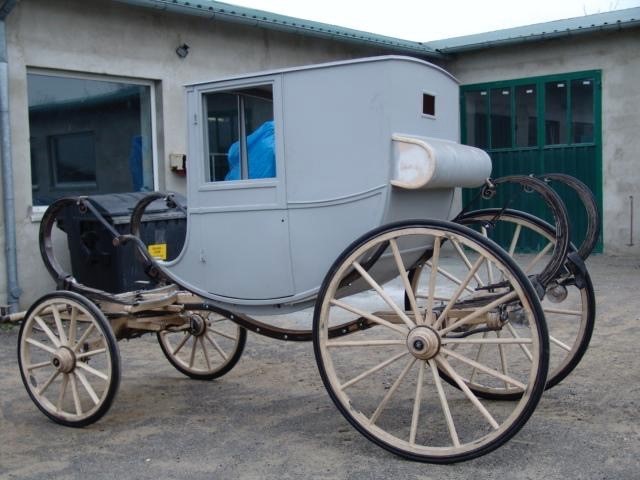
The post-chaise commisioned by Steve Jarman in the process of being built in Poland, 2005.
Local support along the route
It would have been impossible to run the whole event from a central organisation. Local backing and planning expertise were essential. As the route passes through seven Counties (Ed: now recalculated as 8, since the route just clips the far east of Berkshire at Sunningdale), we first needed to establish County Committees which would “own” their section of the route and organise both the plaque unveiling ceremonies along it and complementary events. I therefore contacted Captain Michael Fulford Dobson RN, then Her Majesty’s Lord Lieutenant for Dorset, one of the seven counties through which the route passes. I knew him through another connection and he agreed to introduce me to the corresponding Lords Lieutenant for the other six counties.
On writing to them, they all agreed to set up County Committees in their counties for the project and appoint Chairmen for them. These generally turned out to be senior retired naval officers. The late Admiral Sir Nicholas Hunt, who, before retirement, had commanded both the Channel Fleet and the Trident nuclear submarine squadron, kindly agreed to become President. He and Lady Meriel Hunt provided invaluable and enthusiastic support throughout the whole project
The plaque unveiling ceremony
Together with Peter Warwick and Richard James, I devised a format for the plaque unveiling ceremony that was to be conducted at each of the 21 locations along the Trafalgar Way. There were a number of elements to this. Richard would find a harnessing base for the post chaise about a mile before each plaque location where the four horses from the horse box where the post chaise would be run off the low loader and the four horses harnessed to the vehicle. It would then be driven to the event location in the village, town or city, with Steve Jarman as footman and Elizabeth Jarman riding one of the horses in the role of “post boy”.
The carriage would carry two passengers. The first was an actor, Alex Price, wearing an 18th Century Naval Lieutenant’s uniform made by Henry Poole of Savile Row and a “fore and aft” hat of the period. He would carry a rolled and ribboned copy of the New Trafalgar Dispatch. The second was a young uniformed young naval Sub Lieutenant in training, delegated by the Commanding Officer of The Britannia Royal Naval College at Dartmouth. He would carry a bound facsimile of the facsimile of Vice Admiral Collingwood’s First Trafalgar Dispatch consisting of six handwritten pages. Four officers were to perform this role along sequential sections of the route.
At the location for each ceremony, the plaque would have been already set up for unveiling, the veil consisting of a draped White Ensign. On the arrival of the post chaise, the two occupants would dismount. Alex Price would then salute the principal civic dignitary waiting to receive them by bowing and removing his hat in a formal 18th century gesture. After having first unrolled and declaimed the text of the New Trafalgar Dispatch to the dignitary and the waiting crowd, he would present it to the dignitary. The Naval Officer would then give a modern naval salute and announce that he was carrying a copy of Admiral Collingwood’s First Trafalgar Dispatch. He would follow this with a brief comment about its significance before also presenting it to the dignitary. The dignitary would then be invited to unveil the plaque.
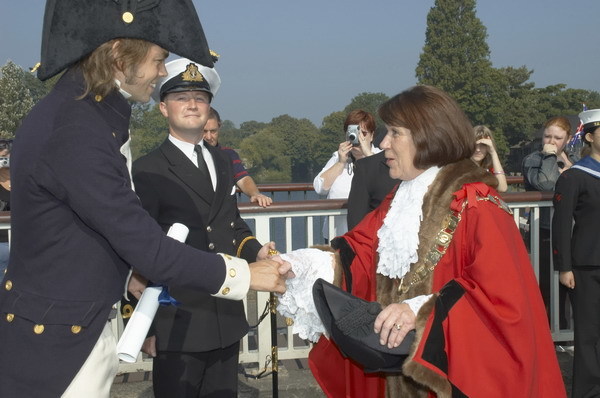
Presenting the New Trafalgar Dispatch to the Mayor of Staines
The ceremony might then be followed by a reception or other event, with the public also being able to ask questions about the battle and related matters being commemorated, and also view, photograph and ask questions about the post chaise. Alex Price and the naval officer would then remount the post chaise, which would leave to drive to a second base beyond the location. Here the horses would be taken out of harness for the whole équipe to be prepared for travel to the next of Lapenotiere’s horse change locations. This procedure precluded the need for the horses to travel long distances on modern hard top roads.
The format set out above would sometimes be varied to take account of practical conditions at each location, but the core events, consisting of the two presentations and the plaque unveiling would always took place.
The Royal Family
The Battle of Trafalgar was an event of national, European and, in terms of its long term consequences, of world significance. So, having evolved a structure for the project, I felt it to be appropriate to enquire as to whether Royal support might be forthcoming. I consulted Admiral Sir Nicholas Hunt, President of our project, for advice on a possible approach. He was supportive of the idea, and took two initiatives. For Cornwall, Sir Nicholas approached the then Lord Lieutenant for the county, Lady Mary Holborough, who agreed to his request to make an approach to Her Royal Highness The Princess Anne. Princess Anne kindly agreed to attend on the quay at Falmouth to receive the new and original dispatches being brought ashore, to attend a Royal Marine Band concert and to meet the disabled crew of the Lord Nelson that had delivered the Dispatches from Cape Trafalgar.
Admiral Hunt, who was also Deputy Lieutenant for Surrey, also arranged for HM Lord Lieutenant of the county to approach His Royal Highness, Prince Edward, Earl of Wessex, with a proposal for him to hold a reception at Bagshot Park. This was to follow the unveiling of the Trafalgar Way Plaque in central Bagshot, with the presentation of the Dispatches to the Lord Lieutenant being made at the reception. He graciously agreed.
The Earl also agreed that we should hold a maritime music concert at Bagshot Park to follow the reception. The concert was to be introduced by the late Richard Baker, who had introduced the Sir Henry Wood Promenade Concerts at the Royal Albert Hall. The bass baritone, Michael George and the soprano Julie Kennard were to be the lead soloists and sing respectively The Old Superb by Stanford and Rule Britannia by Thomas Arne.
The story continues: read Part 3, "The Creation of The Trafalgar Way in 2005".
Missed a bit? Go back to read Part 1, "Preliminary Developments".





